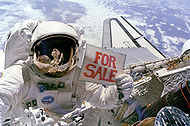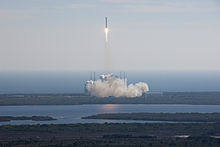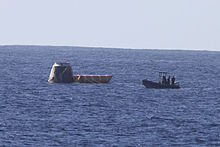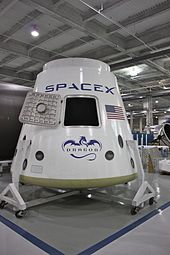- Dragon (spacecraft)
-
SpaceX Dragon spacecraft 
Artist's rendering of the cargo variant of the SpaceX Dragon spacecraft (bottom) berthing to the International Space Station (top). Description Role: Commercial: various roles that put humans and cargo into LEO[1]
Government: supply the International Space Station after retirement of the ShuttleCrew: Dragon Cargo: 0
Dragon Crew: 7Carrier Rocket: Falcon 9 Dimensions Height: 2.9 m 9.51 ft Diameter: 3.6 m 11.8 ft Sidewall angle: 15 degrees Pressurized Volume:[2] 10 m3 353 cu ft Unpressurized Volume:[2] 14 m3 494 cu ft Unpressurized Volume
(with additional trunk extended):[2]34 m3 1,200 cu ft Mass:[3] 4,200 kg 9,260 lb Launch Payload:[2] 6,000 kg 13,228 lb Return Payload:[2] 3,000 kg 6,614 lb Performance Endurance: 1 week to 2 years[2] Re-entry: 3.5 g's[4] The Dragon is a reusable spacecraft developed by SpaceX, a private space transportation company based in Hawthorne, California. During its unmanned maiden flight in December 2010, it became the first commercially-built and -operated spacecraft to ever be successfully recovered from orbit.[5]
The Dragon is contracted to deliver cargo to the International Space Station (ISS) under NASA's Commercial Resupply Services program. Additionally, NASA awarded SpaceX a Commercial Crew Development astronaut-transportation contract in April 2011. The Dragon is designed to carry up to seven astronauts, or a mixture of personnel and cargo, to and from low Earth orbit. The Dragon's heat shield is furthermore designed to withstand re-entry velocities from potential lunar and Martian space flights, for which it has been proposed as a crew vehicle.[6]
Contents
Design
The Dragon is a conventional blunt-cone ballistic capsule with a nose-cone cap that jettisons to reveal a standard International Space Station (ISS) Common Berthing Mechanism. This mechanism allows the The Dragon to be captured by the Space Station Remote Manipulator System and berthed to the non-Russian segments of the ISS. The manned variant of the Dragon will use the NASA Docking System (NDS) for docking.
The Dragon capsule is launched atop a Falcon 9 rocket.[7] SpaceX has built a full-sized prototype of the capsule and "thoroughly tested" its life support system.[8] During its initial cargo and crew flights, the Dragon will land in the sea and be air-lifted to the shore by helicopter, although SpaceX plans to eventually install deployable landing gear and use 8 upgraded SuperDraco thrusters to perform a land-based landing.[9][10][11]
Development
Development started on the Dragon capsule in 2005. In 2006, SpaceX was contracted by NASA to begin demonstration flights of the capsule under the COTS program (see NASA partnership).[12] In June 2009, SpaceX CEO Elon Musk stated that the company planned to conduct the maiden flight of the Dragon spacecraft in 2009, and have the capsule enter service in 2010, before the scheduled final flight of the Space Shuttle.[13] However, the Dragon's maiden flight did not ultimately occur until December 2010, and the Space Shuttle was retired in July 2011, prior to the beginning of the Dragon's commercial operations.[14]
On 23 February 2009, SpaceX announced that its chosen heat shield material, PICA-X (a proprietary variant of NASA's phenolic impregnated carbon ablator material), had passed heat stress tests in preparation for the Dragon's maiden launch.[15] In 2010, Elon Musk stated that the Dragon "is capable of re-entering from a Lunar velocity, or even a Mars velocity with the heat shield that it has."[16]
The first flight of a stripped-down version of the Dragon capsule occurred in June 2010, during the Falcon 9 rocket's maiden flight. This Dragon Spacecraft Qualification Unit was originally used as a non-flying test bed to validate several of the capsule's systems. During its first flight, the unit's primary mission was to relay aerodynamic data captured during the ascent.[17][18] The Dragon spacecraft itself first flew on 8 December 2010, during the second flight of the Falcon 9.[19]
The docking target system for the Dragon module, the DragonEye, was tested in 2009 during the STS-127 Space Shuttle mission, when it was mounted near Space Shuttle Endeavour's docking port and used while the shuttle approached the International Space Station. The DragonEye's LIDAR and thermal imaging capabilities were both tested successfully.[20] The DragonEye flew again on STS-133 in February 2011 for further on-orbit testing.[21]
On 22 November 2010, NASA announced that the Federal Aviation Administration (FAA) had issued a reentry license for the Dragon capsule, the first such license ever awarded to a commercial vehicle.[22]
In summer 2009, SpaceX hired former NASA astronaut Ken Bowersox as vice president of their new Astronaut Safety and Mission Assurance Department, in preparation for manned use of the spacecraft.[23]
In 2009 and 2010, Elon Musk suggested on several occasions that plans for a manned variant of the Dragon were proceeding and had a 2–3 year timeline to completion.[24][25]
NASA partnership
 The Dragon capsule being unwrapped at Cape Canaveral Air Force Station in October 2011, prior to being processed for its COTS 2 demonstration mission.
The Dragon capsule being unwrapped at Cape Canaveral Air Force Station in October 2011, prior to being processed for its COTS 2 demonstration mission.
Commercial cargo transport contracts
In 2005, NASA solicited commercial rocket companies to submit proposals for its Commercial Orbital Transportation Services (COTS) program, which entails the commercial resupply of the International Space Station (ISS), replacing the now-retired Space Shuttle. The Dragon spacecraft was part of SpaceX's proposal, submitted to NASA in March 2006. SpaceX's team for the COTS proposal consisted of a number of companies including MD Robotics, and the Canadian company that built the ISS's Mobile Servicing System.
On 18 August 2006, NASA announced that SpaceX had been chosen, along with Kistler Aerospace, to develop cargo launch services for the ISS. The initial plan called for three demonstration flights of SpaceX's Dragon capsule to be conducted between 2008 and 2010. SpaceX and Kistler were to receive up to $278 million if they met all NASA milestones, but Kistler failed to meet its obligations, and its contract was terminated in 2007.[26][27][28] NASA decided to re-award Kistler's portion of the contract after a competition.[29] On 19 February 2008 NASA announced that it had chosen Orbital Sciences as the new winner.[30]
NASA awarded a cargo delivery contract to SpaceX on 23 December 2008. The contract called for a minimum of 20,000 kg (44,000 lb) of cargo to be carried to the ISS over the course of up to 12 flights, at a cost of US$1.6 billion, with options that potentially increased the maximum contract value to $3.1 billion.[31]
The first of the three contracted demonstration flights was successfully flown on 8 December 2010.[32] A second flight is scheduled to occur in January 2012.[33]
Commercial crew development contracts
In December 2010, SpaceX submitted a proposal under a different NASA solicitation to help NASA transport astronauts to the International Space Station after Space Shuttle retirement. Under phase 2 of the NASA Commercial Crew Development program,[34] SpaceX proposes to develop an "integrated launch abort system design" for the Dragon spacecraft, with several claimed advantages over the more traditional tractor tower approaches used on all prior manned space capsules. These advantages include:[35]
- the provision of crew escape capability "all the way to orbit"
- reusability, since the integrated escape system returns to earth with the spacecraft, and reduces mission cost
- improved crew safety, due to the elimination of one "separation event" from the launch profile
- escape engines which may be usable during the landing phase "for a precise land landing of Dragon under rocket power." The emergency parachute will be retained in this design as a redundant backup landing system.
A video simulation of this escape system's operation was released in January 2011.[10] According to Elon Musk, the developmental cost of a crewed Dragon and Falcon 9 would be between $800 million and $1 billion.[36]
In April 2011, NASA announced that SpaceX would receive $75 million under the CCDev 2 program to advance the development of its side-mounted launch abort system and crew transportation capsule. The CCDev 2 program between NASA and SpaceX began in April 2011 and will run until May 2012. NASA is aiming to be able to fly commercial vehicles to the ISS by 2016.[37] SpaceX's launch abort system received preliminary design approval from NASA in October 2011.[38]
"Red Dragon" Mars mission
As of July 2011[update], NASA Ames Research Center is developing a concept for a low-cost Mars-exploration mission utilising a Falcon Heavy as the launch vehicle and trans-Martian injection vehicle, and the Dragon capsule to enter the Martian atmosphere and house the Mars surface science experiments. The concept would be proposed in 2012/2013 as a NASA Discovery mission for launch in 2018 and arrival at Mars several months later. The science objectives of the mission would include the search for evidence of life on Mars — detecting "molecules that are proof of life, like DNA or perchlorate reductase ... proof of life through biomolecules. ... Red Dragon would drill 3.3 feet (1.0 m) or so underground, in an effort to sample reservoirs of water ice known to lurk under the red dirt." The mission cost is projected to be less than US$425,000,000, not including the launch cost.[39]
Maiden flight
On 8 December 2010, a Falcon 9 rocket lifted off from Cape Canaveral in Florida, carrying an unmanned SpaceX Dragon on COTS Demo Flight 1. The launch was a success, and the Dragon cleanly separated from the Falcon approximately 10 minutes after launch. Three hours of orbital maneuvering tests were conducted at an altitude of 300 kilometres (190 mi; 160 nmi) before a deorbit burn was conducted, putting the Dragon on a re-entry course that ended in a successful splashdown in the Pacific Ocean, approximately 800 kilometres (500 mi; 430 nmi) west of Mexico's Pacific coast.[40]
SpaceX president Gwynne Shotwell stated that this was the first of three primary flight tests under the NASA COTS contract. NASA Administrator Charles Bolden offered his congratulations to SpaceX on the company's successful mission.[41]
Though the Dragon capsule transported neither passengers nor practical cargo, the Space X team launched the spacecraft with a small piece of secret payload. It was revealed more than a day after the successful flight that the secret cargo was a wheel of Le Brouère cheese. The stunt was said to be an homage to the well-known Cheese Shop sketch from the British comedy series, Monty Python's Flying Circus. SpaceX's CEO did not reveal the identity of the cargo during the post-splashdown news conference, for fear of the joke overshadowing the company's accomplishments.[42]
Specifications
The Dragon spacecraft can carry up to seven passengers in its crew configuration[12] or 6,000 kg (13,000 lb) and 24 m3 (850 cu ft) of payload, optionally extensible to 44 m3 (1,600 cu ft), to LEO in its cargo configuration[12]
General specifications for the spacecraft that apply to both its crew and cargo configurations include:
- 18 Draco thrusters,[43] dual-redundant in all axes: any two can fail without compromising the vehicle's control over its pitch, yaw, roll and translation.
- A PICA-X heat shield,[43] designed to withstand Earth atmospheric reentry, even at high return velocities from Lunar and Martian destinations.[6]
Uncrewed version
When used for commercial (non-NASA, non-ISS) flights, the uncrewed version of the Dragon spacecraft is named DragonLab.[44] It is reusable and free-flying, and is capable of carrying both pressurized and unpressurized payloads. Its subsystems include propulsion, power, thermal and environmental control, avionics, communications, thermal protection, flight software, guidance and navigation systems, and entry, descent, landing, and recovery gear."[2] It has a total combined up-mass of 6,000 kilograms (13,000 lb) upon launch, and a maximum down-mass of 3,000 kilograms (6,600 lb) when returning to Earth.[2]
General specifications
- Pressure vessel
- 10 m3 (350 cu ft) interior pressurized, environmentally-controlled, payload volume.[2]
- Onboard environment: 10–46 degrees Celsius (50–115 °F); relative humidity 25~75%; 13.9~14.9 psia air pressure (958.4~1027 hPa).[2]
- Unpressurized sensor bay (recoverable payload)
- 0.1 m3 (4 cu ft) unpressurized payload volume.
- Sensor bay hatch opens after orbital insertion to allow full sensor access to the space environment, and closes prior to reentry to Earth's atmosphere.[2]
- Unpressurized trunk (non-recoverable)
- 14 m3 (490 cu ft) payload volume in the 2.3 m (7 ft 7 in) trunk, aft of the pressure vessel heat shield, with optional trunk extension to 4.3 m (14 ft 1 in) total length, payload volume increases to 34 cubic metres (1,200 cu ft).[2]
- Supports sensors and space apertures up to 3.5 m (11 ft 6 in) in diameter.[2]
- Power, telemetry and command systems
- Power: twin solar panels providing 1,500 W average, 4000 W peak, at 28 and 120 VDC.[2]
- Spacecraft communications: commercial standard RS-422 and military standard 1553 serial I/O, plus Ethernet communications for IP-addressable standard payload service.
- Command uplink: 300 kbps.[2]
- Telemetry/data downlink: 300 Mbps standard, fault-tolerant S-band telemetry and video transmitters.[2]
Production
As of December 2010[update], the SpaceX production line is manufacturing one new Dragon spacecraft every three months.[45]
See also
- Human-carrying spacecraft – descriptions of other proposed vehicles similar to Dragon Crew
- CST-100 – a spacecraft being developed by Boeing, in collaboration with Bigelow Aerospace
- Dream Chaser – a spaceplane being developed by Sierra Nevada Corporation
- As-yet-unnamed "biconic nose cone design orbital vehicle" being developed by by Jeff Bezos's Blue Origin... not to be confused with the Blue Origin New Shepard "vertical-takeoff, vertical-landing (VTVL), suborbital manned rocket" also being developed by Blue Origin
- Multi-Purpose Crew Vehicle – a spacecraft which is being designed by Lockheed Martin for NASA
- Unmanned resupply spacecraft – descriptions of other vehicles similar to Dragon Cargo
- Automated Transfer Vehicle – a similar cargo vehicle developed by ESA in use currently.
- Cygnus spacecraft – a similar cargo vehicle under development by Orbital Sciences Corporation
- H-II Transfer Vehicle – similar cargo vehicle developed by Japan Aerospace Exploration Agency in use currently.
- Progress spacecraft – a similar cargo vehicle developed by Russian Federal Space Agency in use currently.
- Human spaceflight programs
- Private spaceflight
- Splashdown (spacecraft landing)
- COTS Demo Flight 1, the Dragon's successful maiden flight, conducted in December 2010
- COTS Demo Flight 2
- COTS Demo Flight 3
References
- ^ SpaceX Updates Archive for 8 September 2006, 2006-09-08, accessed 19 October 2010. "Bigelow Aerospace and SpaceX have an ongoing dialogue to ensure that F9/Dragon meets the human transportation needs of their planned space station as efficiently as possible."
- ^ a b c d e f g h i j k l m n o p Dragonlab datasheet, 18 September 2009. Retrieved 19 October 2010.
- ^ "SpaceX Brochure – 2008" (PDF). http://www.spacex.com/SpaceX_Brochure_V7_All.pdf. Retrieved 9 December 2010.
- ^ Bowersox, Ken (25 January 2011). "SpaceX Today". SpaceX. http://www.nal-jsc.org/Presentation_NASA%20Alumni%20League_JSC__Bowersox_%20Final_012511%20%282%29.pdf. Retrieved 13 October 2011.
- ^ Bates, Daniel (9 December 2010). "Mission accomplished! SpaceX Dragon becomes the first privately funded spaceship launched into orbit and guided back to Earth". London: Daily Mail. http://www.dailymail.co.uk/sciencetech/article-1336868/SpaceX-Dragon-privately-funded-spaceship-launched-orbit.html. Retrieved 9 December 2010.
- ^ a b Clark, Stephen. "Second Falcon 9 rocket begins arriving at the Cape". Spaceflight Now. http://www.spaceflightnow.com/falcon9/002/100716firststage/. Retrieved 16 July 2010.
- ^ Jones, Thomas D. (December 2006). "Tech Watch — Resident Astronaut". Popular Mechanics 183 (12): 31. ISSN 0032-4558.
- ^ Berger, Brian (8 March 2006). "SpaceX building reusable crew capsule". MSNBC. http://www.msnbc.msn.com/id/11699810/. Retrieved 9 December 2010.
- ^ "Dragon Drop Test – August 20, 2010". Spacex.com. 20 August 2010. http://www.spacex.com/updates.php. Retrieved 9 December 2010.
- ^ a b "Commercial Crew Development (CCDEV) video" (video). SpaceX. 14 January 2011. 3:40. http://www.spacex.com/multimedia/videos.php?id=58. Retrieved 17 January 2011.
- ^ "Elon Musk Congressional testimony October 26, 2011". http://science.house.gov/sites/republicans.science.house.gov/files/documents/hearings/102611_Musk.pdf.
- ^ a b c "Dragon Overview". SpaceX. http://www.spacex.com/dragon.php. Retrieved 17 May 2010.
- ^ "Elon Musk Presentation to Augustine Commission June 2009". SpaceX. http://www.spacex.com/20090617_Elon_Musk_Augustine_Commission.pdf. Retrieved 29 August 2009.
- ^ "STS-135: The Final Voyage". NASA, 27 July 2011. Retrieved 18 October 2011.
- ^ "SpaceX Manufactured Heat Shield Material Passes High Temperature Tests Simulating Reentry Heating Conditions of Dragon Spacecraft" (Press release). SpaceX. 23 February 2009. http://www.spacex.com/press.php?page=20090223. Retrieved 16 July 2009.
- ^ "Second Falcon 9 rocket begins arriving at the Cape". Spaceflight Now. http://spaceflightnow.com/falcon9/002/100716firststage/.
- ^ Guy Norris (20 September 2009). "SpaceX, Orbital Explore Using Their Launch Vehicles To Carry Humans". Aviation Week. http://www.aviationweek.com/aw/generic/story.jsp?id=news/COTS09209.xml&channel=awst.
- ^ "SpaceX Achieves Orbital Bullseye With Inaugural Flight of Falcon 9 Rocket: A major win for NASA’s plan to use commercial rockets for astronaut transport". SpaceX. 7 June 2010. http://www.spacex.com/press.php?page=20100607.
- ^ "Private space capsule's maiden voyage ends with a splash". BBC News, 8 December 2010. Retrieved 16 November 2011.
- ^ Update on 23 September 2009 from SpaceX
- ^ "STS-133: SpaceX’s DragonEye set for late installation on Discovery". NASASpaceFlight.com. 19 July 2010. http://www.nasaspaceflight.com/2010/07/sts-133-spacexs-dragoneye-late-installation-discovery/.
- ^ "NASA Statements On FAA Granting Reentry License To SpaceX" (Press release). 22 November 2010. http://www.nasa.gov/home/hqnews/2010/nov/10-298_NASA_Statements.html.
- ^ "FORMER ASTRONAUT BOWERSOX JOINS SPACEX AS VICE PRESIDENT OF ASTRONAUT SAFETY AND MISSION ASSURANCE" (Press release). SpaceX. 18 June 2009. http://www.spacex.com/press.php?page=20090616. Retrieved 27 July 2009.
- ^ "This Week in Space interview with Elon Musk". Spaceflight Now. 24 January 2010. http://www.youtube.com/watch?v=ifwFa5DtIps&feature=player_embedded.
- ^ "Elon Musk's SpaceX presentation to the Augustine panel". YouTube. June, 2009. http://www.youtube.com/watch?v=O81Zq02eStg.
- ^ "NASA selects crew, cargo launch partners". Spaceflight Now. 18 August 2006. http://www.spaceflightnow.com/news/n0608/18cots/.
- ^ "NASA Selects Crew and Cargo Transportation to Orbit Partners". SpaceRef. 18 August 2006. http://www.spaceref.com/news/viewpr.html?pid=20628.
- ^ Alan Boyle (18 August 2006). "SpaceX, Rocketplane win spaceship contest". MSNBC. http://www.msnbc.msn.com/id/14411983/.
- ^ "Time Runs out for RpK; New COTS Competition Starts Immediately". Space.com. 19 October 2007. http://www.space.com/news/071019-rocketplane-pulledplug.html. Retrieved 9 December 2010.
- ^ NASASpaceflight.com – Orbital beat a dozen competitors to win NASA COTS contract[dead link]
- ^ "F9/Dragon Will Replace the Cargo Transport Function of the Space Shuttle after 2010". SpaceX. 23 December 2008. http://www.spacex.com/press.php?page=20081223. Retrieved 26 January 2009.
- ^ "Launch of SpaceX craft could be milestone for privatized space flight". CNN date=2010-12-08. http://www.cnn.com/2010/US/12/08/space.flight/index.html?hpt=T2. Retrieved 17 January 2011.
- ^ "SpaceX, NASA schedule next Dragon flight for early 2012". Spaceflight Now, 13 November 2011. Retrieved 16 November 2011.
- ^ Spaceship teams seek more funding, msnbc.com, Cosmic Log, 2010-12-10, accessed 14 December 2010.
- ^ "Taking the next step: Commercial Crew Development Round 2". SpaceX Updates webpage. SpaceX. 17 January 2010. http://www.spacex.com/updates.php. Retrieved 17 January 2011.
- ^ NASA expects a gap in commercial crew funding, Spaceflightnow.com, 2010-10-11, accessed 2011-2-28.
- ^ "Commercial Crew Development (CCDEV) Round 2". Space.com. 18 April 2011. http://www.space.com/11421-nasa-private-spaceship-funding-astronauts.html.
- ^ "SpaceX Launch Abort System Receives Preliminary Approval". Wired, 27 October 2011. Retrieved 29 October 2011.
- ^ Wall, Mike (31 July 2011). "'Red Dragon' Mission Mulled as Cheap Search for Mars Life". SPACE.com. http://www.space.com/12489-nasa-mars-life-private-spaceship-red-dragon.html. Retrieved 31 July 2011. "This so-called "Red Dragon" mission, which could be ready to launch by 2018, would carry a cost of about $400 million or less. ... developing the Red Dragon concept as a potential NASA Discovery mission, a category that stresses exploration on the relative cheap. ... NASA will make another call for Discovery proposals in 18 months or so... If Red Dragon is selected in that round, it could launch toward Mars in 2018. ... Assuming that $425 million cap [for NASA Discovery missions] is still in place, Red Dragon could come in significantly under the bar. We'd have money left over to do some science."
- ^ "Private space capsule's maiden voyage ends with splash". bbc.co.uk. BBC News. 8 December 2010. http://www.bbc.co.uk/news/science-environment-11948329. Retrieved 9 December 2010.
- ^ "NASA's Bolden Congratulates SpaceX on Successful Launch". NASAtv. NASAtv. 8 December 2010. http://www.youtube.com/watch?v=QXWEoRDaXPM. Retrieved 8 December 2010.
- ^ "SpaceX's 'secret' payload? A wheel of cheese". latimes.com. LA Times. 9 December 2010. http://latimesblogs.latimes.com/technology/2010/12/spacexs-secret-payload.html. Retrieved 12 December 2010.
- ^ a b "SpaceX Updates — December 10, 2007". SpaceX. 10 December 2007. http://www.spacex.com/updates_archive.php. Retrieved 11 December 2007.
- ^ Dragon Overview, SpaceX, 2010, accessed 11 November 2010. "SpaceX is currently manifesting fully commercial, non-ISS Dragon flights under the name “DragonLab”. DragonLab represents an emergent capability for in-space experimentation."
- ^ Q & A with SpaceX CEO Elon Musk: Master of Private Space Dragons, space.com, 2010-12-08, accessed 9 December 2010. "now have Falcon 9 and Dragon in steady production at approximately one F9/Dragon every three months. The F9 production rate doubles to one every six weeks in 2012."
External links
SpaceX Vehicles Engines Launch Sites Missions Falcon 1Falcon 9Falcon HeavyFlight 1 (2013)Dragon/COTSContracts Unmanned resupply spacecraft Historic TKS
Current In development Cancelled Kistler K-1Components of the International Space Station Overview Assembly · US Orbital Segment · Russian Orbital Segment · Expeditions · Spacewalks · ISS Program · Scientific Research · Major Incidents
Major components
in orbitZarya (Functional Cargo Block) · Zvezda (Service Module) · Unity (Node 1) · Harmony (Node 2) · Tranquility (Node 3) · Destiny (Laboratory) · Columbus (Laboratory) · Kibō (PM, ELM-PS, EF) · Quest (Airlock) · Pirs (Airlock / Docking Module) · Rassvet (MRM 1) · Poisk (MRM 2) · Leonardo (PMM) · Cupola · Integrated Truss Structure (ITS)Subsystems
in orbitFlight-ready hardware
with no launch planScheduled for launch
by ProtonProposed module Cancelled Support vehicles Current: Soyuz · Progress · Automated Transfer Vehicle (ATV) · H-II Transfer Vehicle (HTV)
Future: Dragon · Cygnus · Orion · Rus · CST-100
Former: Space ShuttleMission control centers Space tourism Companies Armadillo Aerospace · Bigelow Aerospace · Blue Origin · EADS Astrium · Mojave Aerospace Ventures · Orbital Sciences Corporation · RocketShip Tours · Scaled Composites · Space Adventures · SpaceX · Virgin Galactic · XCOR Aerospace
Organizations Successful spacecraft Living in space Space competitions Categories:- Human spaceflight
- Manned spacecraft
- Proposed spacecraft
- SpaceX
- Supply vehicles for the International Space Station
Wikimedia Foundation. 2010.



